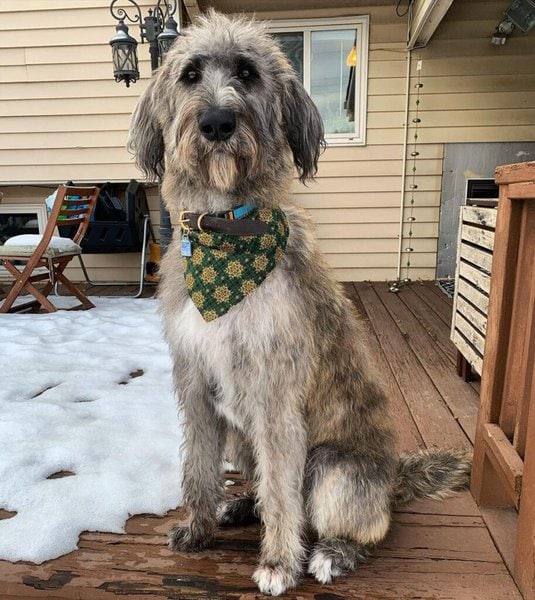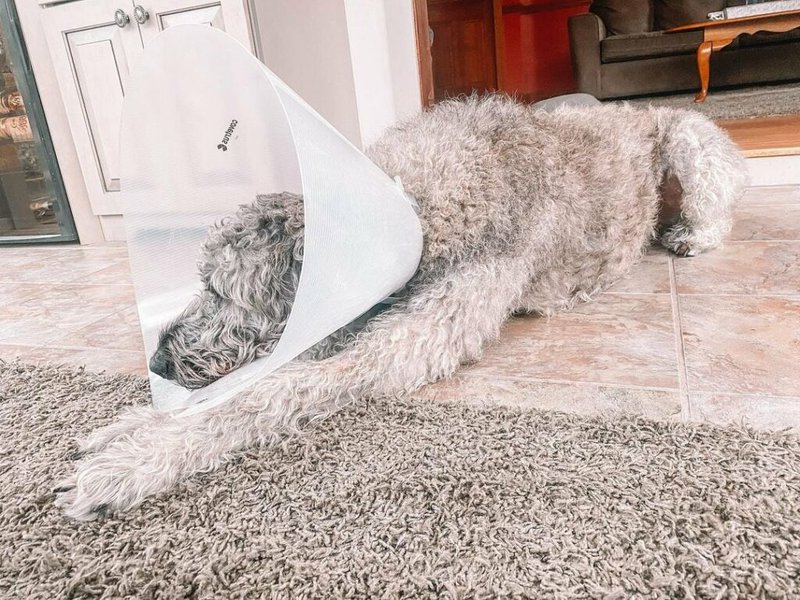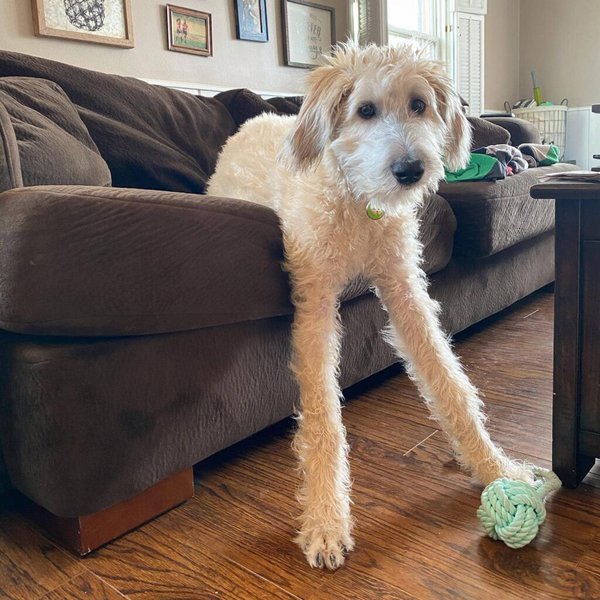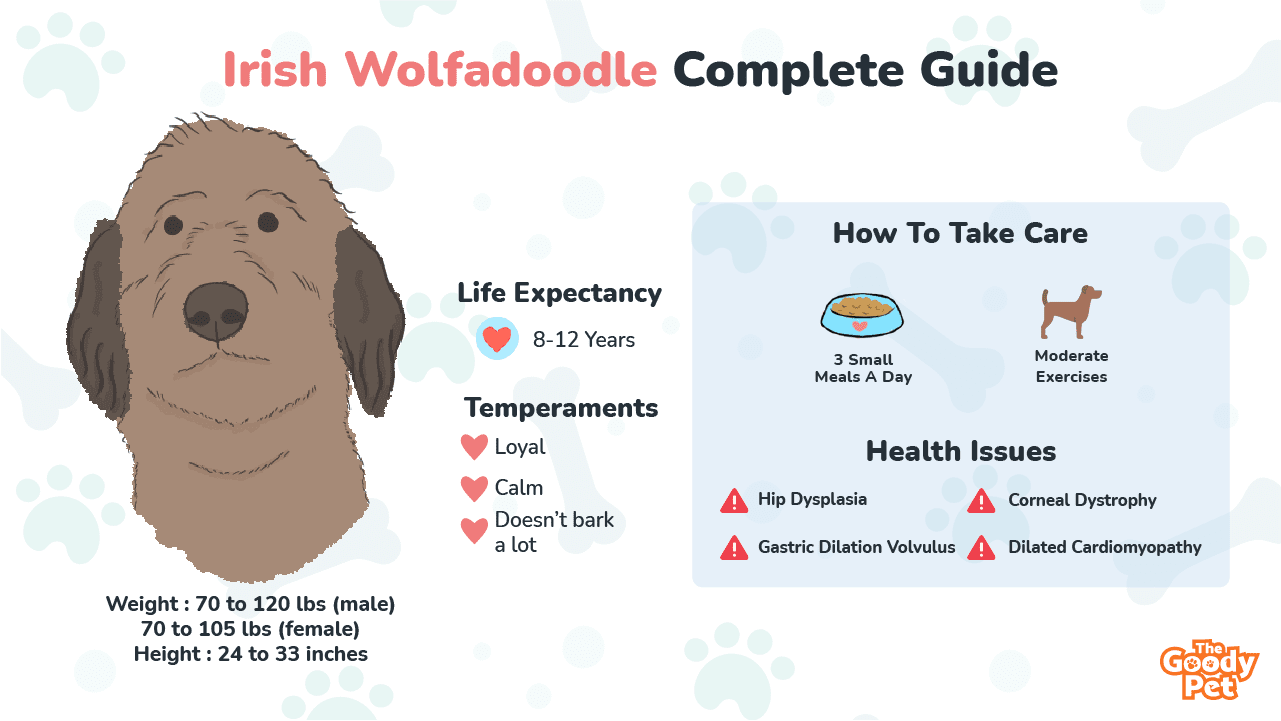Nothing beats owning a canine buddy that has the best of two worlds. The Irish Wolfadoodle has the gentleness and laid-back attributes of an Irish Wolfhound combined with the high intelligence and trainability of a Poodle.
Also known by the name of Woodle, the Irish Wolfadoodle is one of the tallest designer dog breeds in town. The aim of developing the Woodle was to increase the short lifespan of the Irish Wolfhound, which up to now, is successful. However, it is the docile, loving, and goofy personality that will endear you to Irish Wolfadoodle.
Is your personality the perfect match for the Irish Wolfadoodle? Do you have allergies? Are you bothered by too much barking? Do you live in a house with a huge garden? Is the Woodle an active dog? Is the Woodle expensive? We’ll give you answers to these questions, but for now, let’s see how huge an Irish Wolfadoodle is…
What Is An Irish Wolfadoodle?
The Irish Wolfadoodle is one of the giant doodle dog breeds that is produced by crossing a Standard Poodle and an Irish Wolfhound. The Woodle is not as popular because it is relatively a ‘new kid on the block’.
How Big Do Wolfadoodles Get?
On average, both the male and the female Woodles can stand from 24 to 33 inches.
How Much Do Irish Wolfadoodles Weigh?
The male Woodle ranges from 70 to 120 lbs. The female Woodle, on the other hand, is a bit lighter, between 70 to 105 lbs.
Are Irish Wolfadoodles Good Pets?
The size may be intimidating but the Irish Wolfadoodle has a big and good heart. The moment you bring home a Wolfadoodle, you can expect nothing but loyalty, gentleness, and a commitment from a giant canine buddy. The Wolfadoodle can also be the best buddy and protector of young kids, but due to size, adult supervision must be practiced all the time.
In fact, the Irish Wolfadoodles are so good-natured that they are given special roles in therapy homes to assist children and adults with post-traumatic stress and anxiety disorders. The Woodles shine in these environments because of their love for people.
Do you care for other pets at home? If yes, don’t think twice about bringing home an Irish Wolfadoodle because this canine buddy can get along just fine with other furry companions. Just make sure to monitor your Woodle when playing with smaller animals because the Woodle is so big that it can inadvertently hurt your other pets.

How Long Do Irish Wolfadoodles Live?
The Irish Wolfadoodles are healthy dogs that can live between 8 and 12 years.
Similar to other designer dogs, the Woodles may or may not inherit the health issues that are associated with their purebred parents. The most common ones are the following:
Hip Dysplasia
Canine hip dysplasia (CHD) is a painful condition that results from a deformity on the hip. During puppyhood, the thigh bone and the pelvis socket do not grow uniformly. As a result, it leads to the laxity of the joint and arthritis.
Gastric Dilatation Volvulus
A common medical condition that is more prevalent among large dog breeds. This happens when your Irish Wolfadodle eats and drinks too much and then engages in heavy physical activities right away.
In the early stages, the stomach gets filled with gas causing gastric dilation or in layman’s terms, bloating. As the condition progresses, the stomach twists and gets blocked. If you see this happen, take your canine buddy to the vet immediately.
Dilated Cardiomyopathy
Again, Woodles or larger dogs are more susceptible to dilated cardiomyopathy. The heart muscle degenerates resulting in the heart’s muscles failing to contract effectively. The symptoms include coughing, labored breathing, pale gums, among others.
Besides these common issues as described in the above, there are rarer health issues that may happen to a Woodle and we are sharing them here for your awareness.
Corneal Dystrophy
Genetics plays a role in this condition. If inflicted, your Irish Wolfadoodle’s corneas turn into whitish or opaque color. The good news though is that the vision of your canine buddy is not all compromised.
Wobbler Syndrome
A disease in the spine, more common among big dogs. Some of the signs are lameness and neck stiffness.

How To Take Care Of Irish Wolfadoodles?
Your Irish Wolfadoodle completely depends on you, here’s what you can do to give your Woodle the optimum care:
Diet
When choosing the appropriate food for your Woodle, choose a dog food that will meet its nutritional requirements based on your canine buddy’s age and activity level. It is best if you feed your Woodle 3 small meals a day instead of free-feeding. This is done to avoid issues like gastric dilatation volvulus.
Another thing to look for in dog food is the ingredients. Are these ingredients human-grade? Is the dog food loaded with the right amount of animal protein, fruits, and veggies? If not, it’s time to shift to Pet Plate. Your Woodle will surely love the taste and benefit from all the nutritional goodness that comes with Pet Plate dog food.
Should you give multivitamins? In conjunction with high-quality dog food, your Woodle can benefit from taking multivitamins, like the chewable ones. Multivitamins assist in maintaining the coat luster and for stronger immunity.
Exercise
Your Woodle may be big in size but your canine buddy does not really need a vigorous exercise routine. Thus, if you want a canine buddy that you can tag along on your adventures, the Irish Wolfadoodle is not the perfect match for your active lifestyle. The Woodle is pretty much content with moderate walks to keep the muscles strong and nimble.
Dental Care
It’s good for your Woodle if you invest in dental water additives. These prevent bacteria from getting into your canine buddy’s bloodstream that can cause a ton of health problems.
Are Irish Wolfadoodles Aggressive? Temperaments Of Irish Wolfadoodles
Are the Woodles aggressive? Its large body size does give the impression of a dangerous dog but actually, it is the other way around. The Irish Wolfadoodle is not an aggressive but a calm and loyal canine buddy.
Do Irish Wolfadoodles Bark A Lot?
If you are bothered by too much barking, then the Irish Wolfadoodle is the perfect match for you. This is a canine buddy that does not bark too much. In fact, being quiet is one of the much-loved qualities of the Woodles.
Although the Irish Wolfadoodle carries the smart genes of a Poodle, the natural tendency to hunt is not expressed through excessive barking. This gives you (and your neighbors) much-needed peace and restful time.
Trainability
Is your Woodle intelligent as the two purebred parents? Yes, your Woodle is as intelligent as a Poodle and the Irish Wolfhound.
Is it hard to train an Irish Wolfadoodle? Yes, your Irish Wolfadoodle may be smart but the problem is the stubborn, lazy, and laid-back temperaments that make training quite a challenge.
A canine buddy that can easily learn the commands that you teach. It requires patience, consistency, and reward training tools like dog treats and lots of pat on the back to encourage your Irish Wolfadoodle to respond to training.
Adaptability
Due to the large size of the Irish Wolfadoodle, this canine buddy is not suited if you live in an apartment setting. The Woodle will be more comfortable to live in a big house where there is enough space to play around and stretch its huge physique.

Do Irish Wolfadoodles Shed? Grooming Tips For Irish Wolfadoodles
Shedding
If you have an allergy issue, the Woodle is the ideal choice for you. This is because this pooch is a product of two low-shedding parents. Are Irish Wolfadoodles hypoallergenic? Having a low-shedding characteristic, the Irish Wolfadoodles are indeed hypoallergenic, meaning that the fur is not released off its body or in the air that causes allergic reactions to some people.
Tips On Grooming
Regardless of whether your Irish Wolfadoodle inherits the wiry and rough coat of an Irish Wolfhound or the soft and curly hair of a Poodle, your pooch needs a regular grooming session to control loose hair. Failing to groom your pooch results in a heavily matted and unsightly coat condition.
We recommend that you brush the coat of your Woodle 2 to 3 times a week using Furminator Undercoat Tool. What’s amazing about this product is its ergonomic design, making it so easy and comfortable to use. On top of that, you’d see amazing results because the Furminator is effective in removing loose coats, thus, preventing heavy matting of the coat.
And how often should you bathe your Irish Wolfadoodle? Since your Woodle isn’t an active pooch, bathing once a month is recommended. It is best to use an all-natural and organic shampoo and conditioner so as not to strip off the natural oil from your pooch’s skin. We highly recommend the Mighty Petz 2-In-1 Oatmeal Dog Shampoo and Conditioner.
Additional Grooming Tips
Keep those ears dry and clean to prevent bacterial infections. And, don’t forget to trim the nails to prevent the nails from growing and curling into the nail pads.
Related Questions
How Much Does An Irish Wolfadoodle Cost? If you choose to adopt one, you can bring home a puppy for as low as $300. On the other hand, if you choose to buy an Irish Wolfadoodle puppy from a breeder, the price is from $1,500 to $2,800. Factors like age, coat color, and breeder’s reputation are some of the reasons why the prices are not constant.
Can Irish Wolfadoodles Swim? Yes, the Irish Wolfdoodles can swim. Both parents of the Woodle, namely the Irish Wolfhound and the Poodle, were bred as water retrievers. Though the Woodle pups naturally know how to swim, it is still best if you begin training your pup in the shallow water. For safety, we recommend that you let your pup wear a life jacket with a handle.
Can Irish Wolfhounds Get Along With Poodles? Yes, this is because the Irish Wolfhound is known to be a calm, easy-going, and sweet dog. In spite of their commanding size, the Irish Wolfhounds can live peacefully with dogs of all sizes, including a Poodle. The Irish Wolfhounds are also not aggressive at all.





